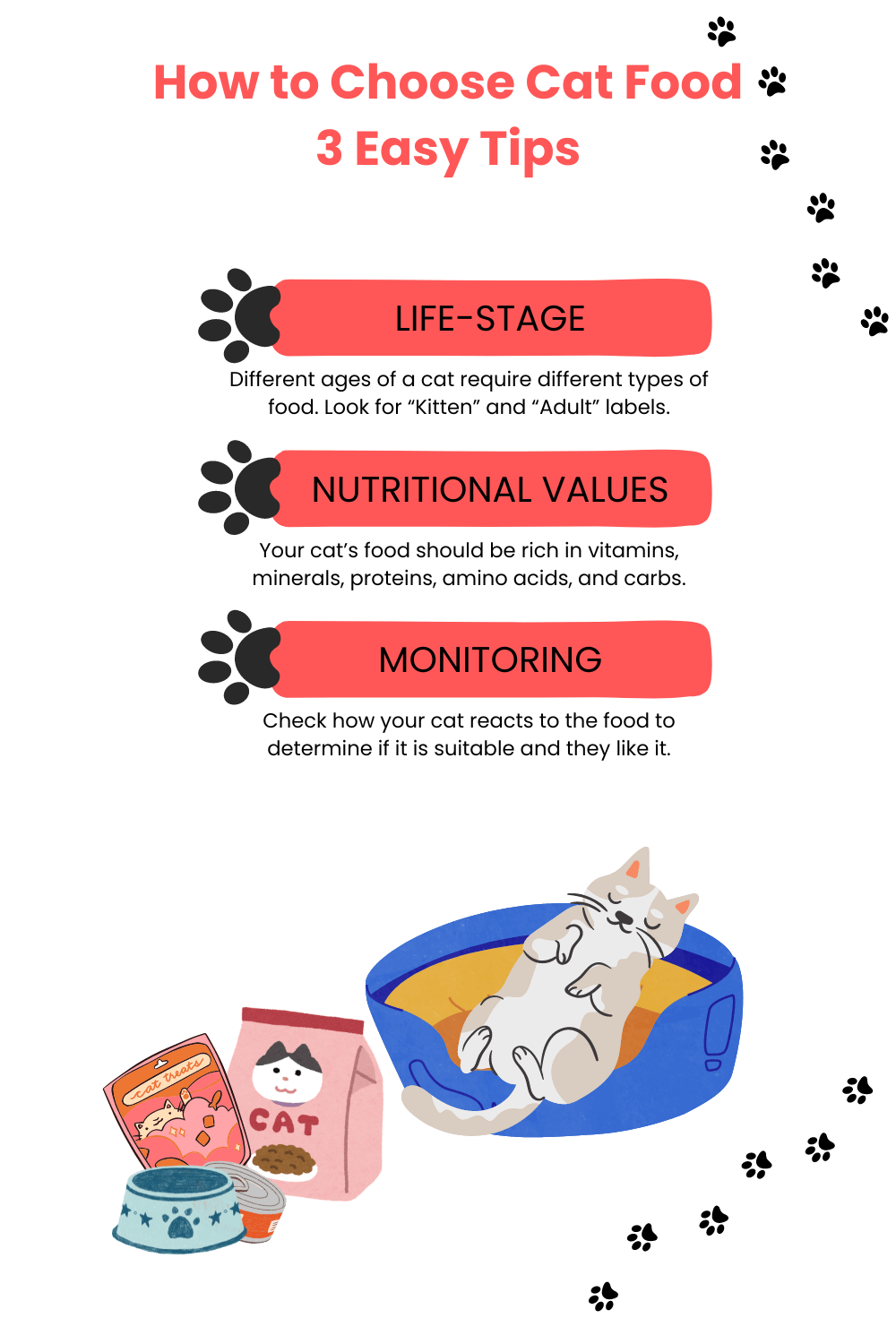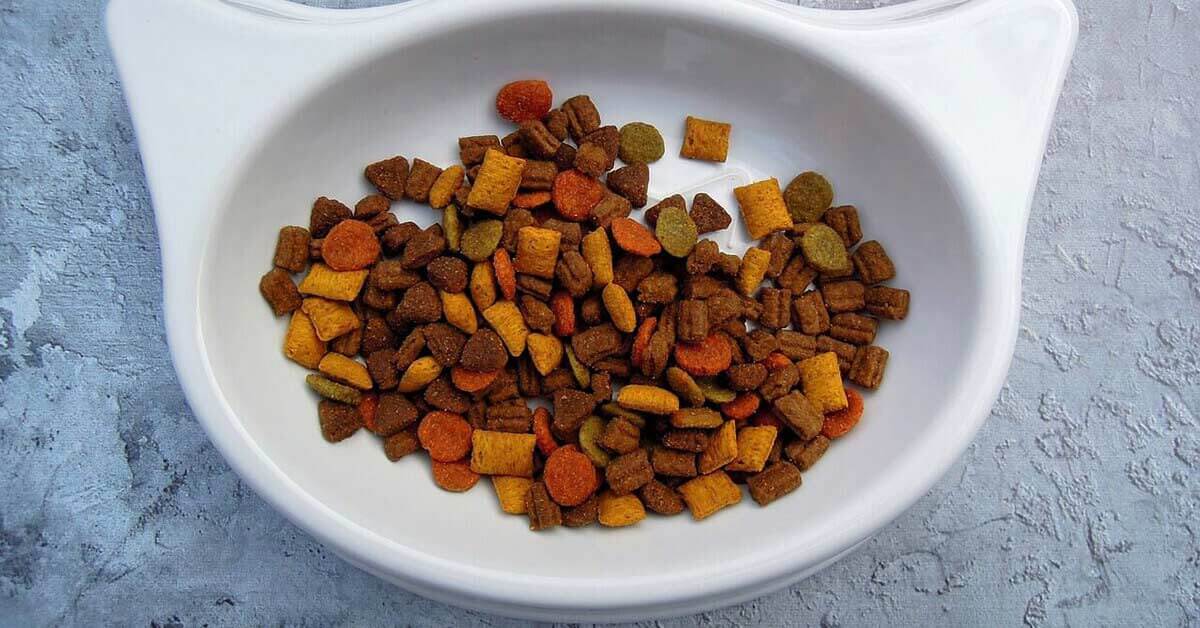How to Choose Cat Food – Tips to Look Out For in 2026
Learning how to choose cat food is not an easy thing to do, especially with so many brands and recommendations out there.
Luckily, we have plenty of experience and are more than happy to share everything with you and hopefully make your food hunting expeditions a lot easier as purr-ents.
Let’s not waste anymore time and dive right in!
4 Main Principles in Choosing Cat Food
Here are the four main aspects you need to be aware of as they are all important in picking the right food for your furry little baby.
1. Take Into Account Your Cat’s Life Stage
Many cat food brands often claim to be suitable and balanced for all ages of cats. At first glance, this might seem quite handy and convenient, but it might not be ideal for your kitten or cat.
The truth is, cats need different types of food as they grow up, similar to how we people function, so it is best to pick food that matches your cat’s life stage.
Here’s what you need to know about the different life stages of your cat:
a) Kittens
Kittens are those little furry babies from day 1 until 12 months old and need nutrition-rich foods to support their overall growth. What to look for in kitten food is very simple – make sure to search for single source protein ingredients, such as chicken, lamb, turkey, beef, or tuna.
Additionally, look for labels “up to 12 months” or “Kitten” on the brand’s packaging. This is a clear indicator that the food is rich in all necessary vitamins and nutrients that would help the little one’s development.
We remember how it was like for our Kiki when we fed her both dry and wet food. One type of food made her gassy, while the other made her really puffy and overweight all of a sudden.
That said, pay close attention to this, especially in the first 6 to 12 months.
b) Adult Cats
Cats over 12 months old are considered adults and should be moved to a different category. A good indicator when choosing cat food for adult cats are labels such as “Adult” on the brand’s packaging.
Moreover, food for adult cats needs to contain less protein and fat compared to kitten food. Another aspect you should consider is the portion size, as you’d need to control the amount you serve to your furry baby.
Adult cats are less active than kittens and might get pretty chonky very quickly if the portion size is not adequate.
As an example, we can safely say that Kiki is on dry food only, is very fit and healthy, and has virtually no fat. This was made possible because we paid very close attention to the portion sizes and ingredients in the adult food we brought home.
c) Senior Cats
According to ASPCA, cats older than seven years are considered senior cats and have specific nutritional needs.
What to look for in cat food for senior cats are the ingredients. You need to make sure that their foods are lower in protein and fat and have a sizable amount of vitamins and minerals to help them strengthen their immune system.
Food for senior cats is typically designed to reduce the work on the kidneys, helping them avoid any sort of kidney diseases.
Our parents have a total of 6 senior cats and all of them eat very little during the day, while sleeping quite a lot. Their food is balanced and rich with all the necessary nutrients to keep them healthy and boost their immune system at the same time.
🐾 When you transition between life stages, make sure you also slowly introduce the new types of food, so your little furry friend can easily accept them and not have any belly issues.
2. Read the Food’s Label for Nutritional Facts
Choosing the right food for your cat means knowing which ingredients are best. So let’s start with the basics, which include:
- Proteins
- Minerals & Vitamins
- Fatty & Amino Acids
- Carbohydrates
Now, let’s dive into each and learn how to choose the right cat food filled with the best nutritious elements:
a) Proteins
Cats are strictly meat eaters, which means they need meat to stay healthy. Important nutrients, including taurine and arachidonic acid, are found only in meat.
Historically, cats were predators with a diet that was rich in proteins, some fat, and a bit of carbohydrates. This means you need to feed your cat food that has lots of proteins, so look for these properties on the brand’s label.
🐾 If your cat shows signs of a food allergy, try changing the main protein in their food first to see if it helps understand the allergy.
b) Minerals & Vitamins
Next on how to choose cat food we have a list of of what your cat’s food should include, such as minerals, vitamins, and amino acids, including:
- Vitamins A, B, and C
- B12
- Folic acid
- Calcium
- Phosphorus
- Sodium
- Iron
- Magnesium
- Zinc
These nutrients are vitally important for strong joints, bones, and teeth in your cat. With a balanced diet, your cat will not need any additional supplements.
However, just to be sure, always undergo regular vet checks before giving any supplements to your cat as some may be harmful.
c) Fatty & Amino Acids
Amino acids are like protein building blocks. Two of the most important ones are Leucine and Lysine, which help with muscles, bones, blood, organs, skin, and coat of your cat.
Young cats and kittens need more energy and protein than adult or senior cats.
Taurine, arginine, and arachidonic acid are also vital for cats. So, if your cat food has good meat, it should have these nutrients since they’re found in animal protein.
d) Carbohydrates
Last, but equally important to learn how to pick cat food, we’ve got carbs. Carbs often get a bad rap because too much can lead to fat. For active cats, though, carbs are incredibly important as they use them for energy, unlike us humans.
- Good carbs in cat food are:
- Rice
- Oats
- Potatoes
Dry kibble often has more carbs than wet or fresh food, so always make sure to check the label for carb amounts per serving.
🐾 Make sure the label shows that the food meets AAFCO standards for balanced animal nutrition.
3. Pay Attention to Your Cat’s Daily Activities
One of the most important aspects of properly feeding your furry baby is monitoring their daily activities. These include how much they play, sleep, stay awake, and how many times they eat throughout the day and the amounts.
a) Activity Levels
Pay close attention to how frequently your cats play, the time they spend playing, and their body shape. This is the best indicator if your cat eats too much, especially since there is no such a thing as “eating too little for healthy cats”.
However, in the event that your cat eats too little, while being less active than usual, then our advice would be to immediately take your cat to the vet for a health checkup.
b) Eating Regime
There are many theories to how much you should feed your cat each day on both ends of the extreme. Some say you should feed your cat in portions, while others suggest leaving food in the cat bowl so your cat can eat whenever they want to.
What we noticed with our Kiki is that leaving food in her cat bowl is best, as she’ll eat whenever she feels hungry. She never eats more than she needs to.
However, there is one drawback as the food left out in the open is oxidized, so it’s best practice to serve smaller amounts and refill the bowls often when they run low.
More importantly, though, you should be aware of the type of food you give to your cat. We’ll address this in the next section.
4. The Types of Cat Food Determine Your Cat’s Health
There are various types of food you can give to your cat, and the choice comes down to these four categories: dry, wet, raw, and homemade varieties.
Additionally, you should also learn about grains and taurine, which is what we’ll talk about further below. That said, we’re not going to pay much attention to raw and homemade varieties, as we strongly believe purr-ents should avoid these foods.
Now, let’s check out the most common types you’ll encounter and what to look for in each:
a) Dry Cat Food
Dry food is the basic type you should give to your cat. It has about 6% to 10% of water content and ingredients are often mixed, shaped, and dried into smaller pieces.
Animal fat that serves as flavor enhancers is also added, which makes dry food highly affordable and rarely spoilable. If you want to know what to look for in dry cat food, pay attention to the taurine levels as well.
When you use dry food, make sure you store it in a cool, dry place, and always check for the expiration date. Larger amounts can last for months, but expired food can lose all of its vital nutrients and go bad. Use airtight containers to keep the food fresh and tasty.
b) Wet Cat Food
Wet food, on the other hand, has at least 75% moisture and provides quality hydration. It is more expensive, though, but highly appealing to cats.
Once you open wet food, be it from a can or a pouch, make sure to store the remains in a fridge. Before buying, though, always check the labels for nutritional completeness, as many lack the essential nutrients, and can be very bad for your cat.
You should also check the taurine percentages, as we have noticed vast differences in Kiki’s behavior when we gave her food that contained high levels of taurine, versus food that contained lower levels of it.
What kind of behavior do you ask?
Well, let’s just say she tried getting back to her roots as a predator and wanted to constantly attack mommy and daddy, instead of being the sweet little girl we know and love.
🐾 Our advice is to primarily feed your cat dry food and treat them with wet food only on certain occasions or, as our vet says, when it’s their birthday. Dry food has all the necessary nutrients, so you don’t have anything to worry about.
Final Remarks on How to Choose Cat Food
There isn’t a one-fix solution to choosing the right food for your cat. You have to read the labels and pick food according to your cat’s life stage and nutritional requirements.
We advise you to feed your cat only with dry food and treat them with wet food, in the form of pouches, only on specific occasions or very rarely.
Most importantly, always check how your cat behaves before eating, after eating, and when going into her litter box. These can all be indicators that your cat’s tummy likes or dislikes the food you give them on a daily basis.
We hope you found this article useful and helpful in assisting you to learn how to choose cat food that’s just right for your little furry friend.


